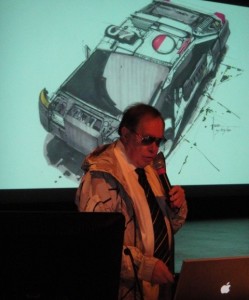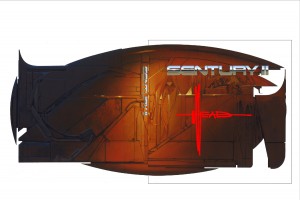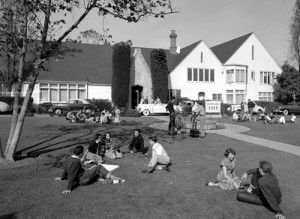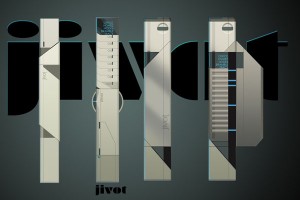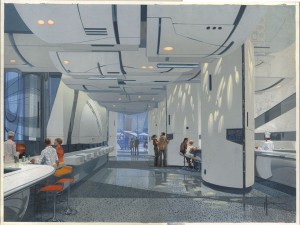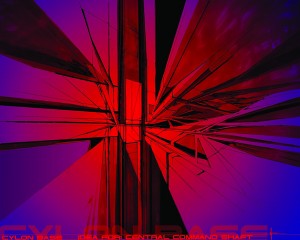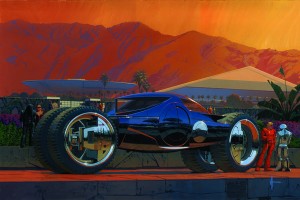Legendary visual futurist and Art Center alumnus Syd Mead stopped by Art Center last month as part of the Design Studio Press Spring Lecture Series.
His lecture traversed the history of automobile design, the future of transportation, his early work for Ford and U.S. Steel, his work on Blade Runner and his latest book Sentury II.
We followed up with the designer via email to ask him about Sentury II.
Dotted Line: You mentioned in your lecture that the cover of Sentury II is intended to look like a metallic artifact that might be found in the future. What’s happening in the scene depicted in the artifact?
Mead: On the left of the spine of the book is a series of manifolds, circuitry and panels that simulate the energy feed to the image coherent side at the right (the actual cover of the book). I show a stylized, ceremonial figure just to the right of the book spine (the center of the overall artwork) and a horizontal split that reveals an energy source (heat? photon glow?) from behind the front surface of the plate combination.
At far right, just above the glowing energy source horizontal is a tableaux of figures and fixtures. One figure is entering a vehicle of some sort while behind him are a series of figures depicting a montage of social interaction, stylized foliage and geometric alignments that eventually go parallel to the outer edge of the ‘artifact.’
I imagined that this entire piece might have been dug up, cleaned off and somehow energized to bring the overall surface detail into view. The overall look of the cover art is a deliberate homage to the cover of Sentury II, which I painted first.
Dotted Line: In the dedication of Sentury II, you mention that John Mueller Reinhart steered you to Art Center. Could you elaborate a bit more on that?
Mead: I was in the Army on Okinawa when the Lincoln division of Ford Motor Company came out with announcements of the new Lincoln Continental. Being a naive guy I thought, “Why don’t they name it something American, like Mohawk, Montana or some other iconic American name?”
John was the head of Ford styling at the time, so I sent him some of my car drawings. He wrote back saying, “If you like car design you should go to this school in Los Angeles, the Art Center School.” When I processed out of the Army in June of 1956, I flew down to L.A., presented my portfolio (which I had put together while on Okinawa), and was accepted on the spot with a “Can you start this coming September?” I did and graduated two and a half years later in 1959.
Dotted Line: Sentury II features a number of devices, branded as “Jivot,” that you designed for Mike Simpson Design. You describe the devices as PDA wands that also emit aromas and mists. Could you explain how people would use these devices a bit further?
Mead: We have seen several electronic products merge to form a new kind of appliance or personal media device. They were dubbed PDAs and now combine camera (both still and motion picture), phone, keyboard and other functions that depend on a computerized range of facility.
My version was adding a replaceable cartridge that would emit both a tasted mist and/or a pleasant odor making the resulting device an everything thing. This result was inevitable and I presented graduate design students of the Tokyo/Osaka University with the exact same challenge about twenty years ago at the start of the enhanced digital personal device progression.
Dotted Line: In your lecture, you mentioned that controlling your design from conception to the final format never happens. Or rarely. Is there an example in Sentury II where the final outcome either perfectly matched, or came close to matching, your original concept?
Mead: Last year I finished design on a new high-end restaurant in New York City in a new 54-story building. [It’s] a combination of hotel, condos and two levels of food service. The final result followed my design really exactly, given slight compromises for city codes and public access protocols. The overall result, however, is very satisfying.
Dotted Line: In Sentury II, you include some gorgeous sketches for a proposed Battlestar Galactica video game that never came to fruition. Does it bother you when projects don’t materialize?
Mead: The answer is always no. I’m not a banker. I’m paid to imagine a coherent response to a very specific creative challenge. I do that, it’s approved by the client and from there on, it’s money. If I’m requested to come back into the project to make compromises and other adjustments to fit what the project is running into, we engage in an ‘extension’ part of the original contract. I always am ready for the project I’m working on to die. And, the larger and more expensive (more dollars or whatever currency is floating the venture) the project is, and usually the more agencies are involved, that project is much more fragile in terms of actual completion.
Dotted Line: You also feature a number of future transportation vehicles in Sentury II — Floaters, Hypervan, Megacoach, Monster Bike — what would you say all these vehicles have in common?
Mead: The only common characteristic they really share is that they don’t (and may never) exist. They are sort of imaginary prototypes of possible future transport ideas.
Dotted Line: Which vehicle would you most like to see come to life?
Mead: I would love to have a real Megacoach. Have no idea where I’d drive it but it would be an absolute kick.

